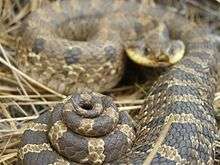Eastern hognose snake
| Eastern hognose snake | |
|---|---|
 | |
| eastern hog-nosed snake (southern Georgia morph) | |
| Scientific classification | |
| Kingdom: | Animalia |
| Phylum: | Chordata |
| Subphylum: | Vertebrata |
| Class: | Reptilia |
| Order: | Squamata |
| Suborder: | Serpentes |
| Family: | Colubridae |
| Subfamily: | Xenodontinae |
| Genus: | Heterodon |
| Species: | H. platirhinos |
| Binomial name | |
| Heterodon platirhinos Latreille in Sonnini & Latreille, 1801 | |
| Synonyms | |
| |
Heterodon platirhinos, commonly known as the eastern hog-nosed snake,[2] spreading adder,[3] or deaf adder, is a harmless colubrid species endemic to North America.[4] No subspecies are currently recognized.[2]
Geographic range
Heterodon platirhinos is found from eastern-central Minnesota, and Wisconsin to southern Ontario, Canada and extreme southern New Hampshire, south to southern Florida and west to eastern Texas and western Kansas.[5]
Description




The average adult measures 71 cm (28 in) in total length (body + tail), with females being larger than males. The maximum recorded total length is 116 cm (46 in).[6]
The most distinguishing feature is the upturned snout, used for digging in sandy soils.
The color pattern is extremely variable. It can be red, green, orange, brown, gray to black, or any combination thereof depending on locality. They can be blotched, checkered, or patternless. The belly tends to be a solid gray, yellow, or cream-colored. In this species the underside of the tail is lighter than the belly.[7]
Venom
Although H. platyrhinos is rear-fanged, it is often considered nonvenomous because it is not harmful to humans. Heterodon means "different tooth", which refers to the enlarged teeth at the rear of the upper jaw. These teeth inject a mild amphibian-specific venom into prey, and also are used to "pop" inflated toads like a balloon to enable swallowing. Bitten humans who are allergic to the saliva have been known to experience local swelling, but no human deaths have been documented.
Common names
Eastern hog-nosed snake,[2] spreading adder, hog-nosed snake, adder, bastard rattlesnake, black adder, black blowing viper, black hog-nosed snake, black viper snake, blauser, blower, blowing adder, blowing snake, blow(ing) viper, blow snake, buckwheat-nose snake, calico snake, checkered adder, checquered adder, chunk head, common hog-nosed snake, common spreading adder, deaf adder, eastern hognose snake, flat-head, flat-head(ed) adder, hay-nose snake, hissing adder, hissing snake, hog-nosed adder, hog-nosed rattler, hog-nose snake, hog-nosed viper, hissing viper, (mountain) moccasin, North American adder, North American hog-nosed snake, pilot, poison viper, puff(ing) adder, red snake, rock adder, rossel bastard, sand adder, sand viper, spotted (spreading) adder, spread nelly, spread-head moccasin, spread-head snake, spread-head viper, flat-head adder (spreading) viper.[3]
Conservation status
This species is classified as Least Concern (LC) on the IUCN Red List of Threatened Species (Year assessed: 2007).[8] However, it is a species of increasing conservation concern, especially in the northeastern part of its range.[9][10][11][12] Of the five states in the northeast U.S. where the eastern hognose snake occurs, it currently has “listed” conservation status in four (Connecticut, New Hampshire, New York, and Rhode Island).[13] Noted declines are believed to be the result of direct anthropogenic pressures including habitat loss and fragmentation, road mortality, environmental degradation, and intentional killing.[14][15]
Defensive behavior
When threatened, the neck is flattened and the head is raised off the ground, not unlike a cobra. They also hiss and will strike, but they do not attempt to bite. The result can be likened to a high speed head-butt. If this threat display does not work to deter a would-be predator, a hognose snakes will often roll onto its back and play dead, going so far as to emit a foul musk from its cloaca and let its tongue hang out of its mouth.[7][16][17]
Feeding
The Eastern hognose snake feeds extensively on amphibians, and has a particular fondness for toads. This snake has resistance to the toxins toads secrete. This immunity is thought to come from enlarged adrenal glands which secrete large amounts of hormones to counteract the toads' powerful skin poisons. At the rear of each upper jaw, they have greatly enlarged teeth, which are neither hollow nor grooved, with which they puncture and deflate toads to be able to swallow them whole.[6][16][18] They will also consume other amphibians, like frogs and salamanders.
Captivity
Eastern hognose snakes are occasionally available in the exotic pet trade, but due to their specific dietary requirements, they are not as readily available as other species. Generally, they refuse feeder rodents unless they are scented with amphibians. In Canada, Eastern hognose snakes are considered to be a species-at-risk (COSEWIC designation: Threatened), and consequently capture or harassment of these animals, including their captive trade, is illegal.
These snakes live for approximately 12 years. They shed their skin periodically to grow and develop.
Reproduction
Eastern hognose snakes mate in April and May. The females, which lay 8 - 40 eggs (average about 25) in June or early July, do not take care of the eggs or young. The eggs, which measure about 33 mm × 23 mm (1 1⁄4 in × 1 in), hatch after about 60 days, from late July to September. The hatchlings are 16.5–21 cm (6.5–8.3 in) long.[17]
Gallery
-

H. platirhinos eating a toad.
-

H. platirhinos.
References
- ↑ Heterodon platirhinos at the Reptarium.cz Reptile Database. Accessed 14 September 2007.
- 1 2 3 "Heterodon platirhinos". Integrated Taxonomic Information System. Retrieved 14 September 2007.
- 1 2 Wright, A.H., and A.A. Wright. 1957. Handbook of Snakes of the United States and Canada. 2 volumes. Comstock Publishing Associates. Ithaca and London. (7th printing, 1985). 1105 pp. ISBN 0-8014-0463-0. (Heterodon platyrhinos, pp. 305-312, Figures 93-94, Map 29.)
- ↑ McCoy, C.J., Jr., and A.V. Bianculli. 1966. The distribution and dispersal of Heterodon platyrhinos in Pennsylvania. Journal of the Ohio Herpetological Society 5 (4): 153-158.
- ↑ Behler, J.L., and F.W. King. 1979. The Audubon Society Field Guide to North American Reptiles and Amphibians. Alfred A. Knopf. New York. 744 pp.
- 1 2 Smith, H.M., and E.D. Brodie, Jr. 1982. Reptiles of North America: A Guide to Field Identification. Golden Press. New York. 240 pp. ISBN 0-307-13666-3. (Genus Heterodon and species Heterodon platyrhinos, pp. 164-167.)
- 1 2 Conant, R. 1975. A Field Guide to Reptiles and Amphibians of Eastern and Central North America, Second Edition. Houghton Mifflin. Boston. 429 pp. (Genus Heterodon and species Heterodon platyrhinos, pp. 168-170 + Plate 25 + Map 130.)
- ↑ Heterodon platirhinos at the IUCN Red List. Accessed 14 September 2007.
- ↑ Klemens, MW (1993). "Amphibians and Reptiles of Connecticut and Adjacent Regions". State Geological and Natural History Survey of Connecticut.
- ↑ Therres, GD (1999). "Wildlife species of regional conservation concern in the northeastern United States". Northeast Wildlife.
- ↑ Seburn, D (2009). "Recovery strategy for the eastern hognose snake (Heterodon platirhinos) in Canada.". Species at risk act recovery series.
- ↑ NEPARC. 2010. Northeast amphibian and reptile species of regional responsibility and conservation concern. Northeast Partners in Amphibian and Reptile Conservation (NEPARC) Publication 2010-1.
- ↑ Buchanan, Scott (2012). "Ecology of the Eastern Hognose Snake (Heterodon platirhinos) at Cape Cod National Seashore, Barnstable County, Massachusetts" (PDF). Montclair State University.
- ↑ Ernst, CH and EM (2003). Snakes of the United States and Canada. Smithsonian Books.
- ↑ Gibbons, J.W., Scott, D.E., Ryan, T.J., Buhlmann, K.A., Tuberville, T.D., Metts, B.S., Greene, J.L., Mills, T.,Leiden, Y., Poppy, S., and C.T. Winne. 2000. The global decline of reptiles, déjà vu amphibians. BioScience 50: 653-666.
- 1 2 Goin, C.J.; O.B. Goin; G.R. Zug. 1978. Introduction to Herpetology, Third Edition. W.H. Freeman. San Francisco. xi + 378 pp. ISBN 0-7167-0020-4. (Heterodon, pp. 167, 328-329.)
- 1 2 Schmidt, K.P., and D.D. Davis. 1941. Field Book of Snakes of the United States and Canada. G.P. Putnam's Sons. New York. 365 pp. (Heterodon contortrix, pp. 115-118, Figures 25-26 + Plate 11.)
- ↑ Boulenger, G.A. 1894. Catalogue of the Snakes in the British Museum (Natural History). Volume II., Containing the Conclusion of the Colubridæ Aglyphæ. Trustees of the British Museum (Natural History). London. xi + 382 pp. + Plates I.- XX. (Heterodon platyrhinus, pp. 154-156.)
Further reading
- Conant, R., and W. Bridges. 1939. What Snake Is That? A Field Guide to the Snakes of the United States East of the Rocky Mountains. With 108 drawings by Edmond Malnate. D. Appleton-Century. New York and London. Frontispiece map + viii + 163 pp. + Plates A-C, 1-32. (Heterodon contortrix, pp. 39–40 + Plate 4, Figure 11; Plate 5, Figure 13.)
- Holbrook, J.E. 1842. North American Herpetology; or, A Description of the Reptiles Inhabiting the United States. Vol. IV. J. Dobson. Philadelphia. 138 pp. (Heterodon platirhinos, including synonym Heterodon niger, pp. 62–70, Plates XVI.- XVII.)
- Latreille, P.A. In Sonnini, C.S., and P.A. Latreille. 1801. Histoire naturelle des reptiles, avec figures dessinées d'apres nature; Tome IV. Seconde Partie. Serpens. Crapelet. Paris. 410 pp. (Heterodon platirhinos, new species, pp. 32–37.)
- Morris, P.A. 1948. Boy's Book of Snakes: How to Recognize and Understand Them. A volume of the Humanizing Science Series, edited by Jacques Cattell. Ronald Press. New York. viii + 185 pp. ("The Hog-Nosed Snake", "Heterodon platyrhinos ", pp. 52–57, 179.)
- Zim, H.S., and H.M. Smith. 1956. Reptiles and Amphibians: A Guide to Familiar American Species: A Golden Nature Guide. Simon and Schuster. New York. 160 pp. (Heterodon contortrix, pp. 81, 156.)
